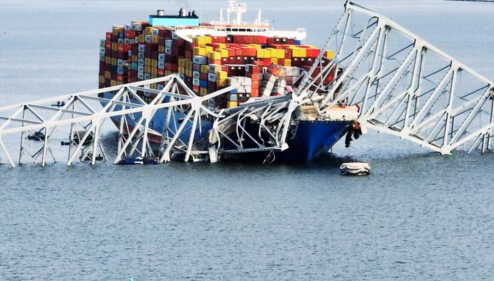In a shocking incident early Tuesday morning, the Francis Scott Key Bridge in Baltimore collapsed after being struck by a large container ship. The bridge carried Interstate 695 over the Patapsco River, a critical transportation artery southeast of the Baltimore metropolitan area. Up to seven people may have fallen into the water after vehicles on the bridge were impacted, with two rescued so far.
This catastrophic event has wide-ranging implications, not just for the tragic loss of life and regional transportation, but also for the shipping and logistics industry. The container ship involved has been identified as the Singapore-flagged DALI, a 948-foot vessel chartered by shipping giant Maersk and operated by Synergy Marine Group.
While the cause is still under investigation, the incident starkly highlights the risks and vulnerabilities faced by the shipping industry and supply chains. A single accident can bring a vital port and transportation hub to a standstill. The U.S. Coast Guard has already suspended all vessel traffic in and out of the Port of Baltimore until further notice.
This is likely to cause significant disruptions and delays, not just for Baltimore but rippling across global shipping routes and supply chains that rely on the port. The Port of Baltimore handled over 15 million tons of foreign cargo in 2021 and is a critical gateway for international trade on the U.S. East Coast.
Investors in the shipping and logistics sectors will be watching developments closely. Major players like Maersk could face legal liabilities, higher insurance costs, reputational damage, and loss of business from prolonged port closures. Smaller shipping companies that rely on the Baltimore port may be even more heavily impacted operationally and financially.
The incident also casts a harsh spotlight on the state of U.S. infrastructure. Despite the Biden administration’s efforts through the Bipartisan Infrastructure Law, incidents like this underscore the costs and risks of deficient transportation infrastructure. According to the American Road & Transportation Builders Association, over 43,000 bridges across the U.S. are classified as structurally deficient.
This could spur renewed focus on infrastructure spending and improvements, creating potential opportunities for companies involved in construction, engineering, and building materials. However, it also highlights risks for industries like trucking and logistics that depend heavily on safe and reliable transportation networks.
In the small cap space, companies with localized operations around the Baltimore area could face disruptions to business activity and supply chains. This may create trading opportunities for investors watching the impacts closely. Conversely, small caps that provide solutions for infrastructure monitoring, maintenance and security may see increased interest.
Overall, while the human toll is the primary tragedy, this incident is likely to have significant ripple effects across the economy, policy landscape and investment markets in the weeks and months ahead. Investors would be wise to closely monitor developments and reassess potential risks and opportunities across sectors like shipping, infrastructure, and industrial small caps.
